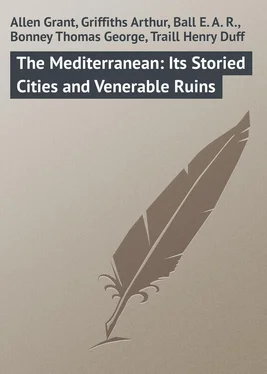E. Ball - The Mediterranean - Its Storied Cities and Venerable Ruins
Здесь есть возможность читать онлайн «E. Ball - The Mediterranean - Its Storied Cities and Venerable Ruins» — ознакомительный отрывок электронной книги совершенно бесплатно, а после прочтения отрывка купить полную версию. В некоторых случаях можно слушать аудио, скачать через торрент в формате fb2 и присутствует краткое содержание. Жанр: Путешествия и география, foreign_prose, foreign_language, на английском языке. Описание произведения, (предисловие) а так же отзывы посетителей доступны на портале библиотеки ЛибКат.
- Название:The Mediterranean: Its Storied Cities and Venerable Ruins
- Автор:
- Жанр:
- Год:неизвестен
- ISBN:нет данных
- Рейтинг книги:3 / 5. Голосов: 1
-
Избранное:Добавить в избранное
- Отзывы:
-
Ваша оценка:
- 60
- 1
- 2
- 3
- 4
- 5
The Mediterranean: Its Storied Cities and Venerable Ruins: краткое содержание, описание и аннотация
Предлагаем к чтению аннотацию, описание, краткое содержание или предисловие (зависит от того, что написал сам автор книги «The Mediterranean: Its Storied Cities and Venerable Ruins»). Если вы не нашли необходимую информацию о книге — напишите в комментариях, мы постараемся отыскать её.
The Mediterranean: Its Storied Cities and Venerable Ruins — читать онлайн ознакомительный отрывок
Ниже представлен текст книги, разбитый по страницам. Система сохранения места последней прочитанной страницы, позволяет с удобством читать онлайн бесплатно книгу «The Mediterranean: Its Storied Cities and Venerable Ruins», без необходимости каждый раз заново искать на чём Вы остановились. Поставьте закладку, и сможете в любой момент перейти на страницу, на которой закончили чтение.
Интервал:
Закладка:
T. G. (Thomas Gray) Bonney, E. A. R. Ball, H. D. Traill, Grant Allen, Arthur Griffiths
The Mediterranean: Its Storied Cities and Venerable Ruins
I
THE PILLARS OF HERCULES
Portals of the ancient world – Bay of Tangier at sunrise – Tarifa – The Rock of Gibraltar – Wonders of its fortifications – Afternoon promenade in the Alameda Gardens – Ascending the Rock – View from the highest point – The Great Siege – Ceuta, the principal Spanish stronghold on the Moorish coast – The rock of many names.
The “Pillars of Hercules!” The portals of the Ancient World! To how many a traveller just beginning to tire of his week on the Atlantic, or but slowly recovering, it may be, in his tranquil voyage along the coasts of Portugal and Southern Spain, from the effects of thirty unquiet hours in the Bay of Biscay, has the nearing view of this mighty landmark of history brought a message of new life! That distant point ahead, at which the narrowing waters of the Strait that bears him disappear entirely within the clasp of the embracing shores, is for many such a traveller the beginning of romance. He gazes upon it from the westward with some dim reflection of that mysterious awe with which antiquity looked upon it from the East. The progress of the ages has, in fact, transposed the center of human interest and the human point of view. Now, as in the Homeric era, the Pillars of Hercules form the gateway of a world of wonder; but for us of to-day it is within and not without those portals that that world of wonder lies. To the eye of modern poetry the Atlantic and Mediterranean have changed places. In the waste of waters stretching westward from the rock of Calpe and its sister headland, the Greek of the age of Homer found his region of immemorial poetic legend and venerable religious myth, and peopled it with the gods and heroes of his traditional creed. Here, on the bosom of the wide-winding river Oceanus, lay the Islands of the Blest – that abode of eternal beauty and calm, where “the life of mortals is most easy,” where “there is neither snow nor winter nor much rain, but ocean is ever sending up the shrilly breezes of Zephyrus to refresh man.” But for us moderns who have explored this mighty “river Oceanus,” this unknown and mysterious Atlantic to its farthest recesses, the glamor of its mystery has passed away for ever; and it is eastward and not westward, through the “Pillars of Hercules,” that we now set our sails in search of the region of romance. It is to the basin of the Mediterranean – fringed with storied cities and venerable ruins, with the crumbling sanctuaries of a creed which has passed away, and the monuments of an art which is imperishable – that man turns to-day. The genius of civilization has journeyed far to the westward, and has passed through strange experiences; it returns with new reverence and a deeper awe to that enclave of mid-Europe which contains its birthplace, and which is hallowed with the memories of its glorious youth. The grand cliff-portal which we are approaching is the entrance, the thoughtful traveller will always feel, to a region eternally sacred in the history of man; to lands which gave birth to immortal models of literature and unerring canons of philosophic truth; to shrines and temples which guard the ashes of those “dead but sceptered sovereigns” who “rule our spirits from their urns.”
As our vessel steams onward through the rapidly narrowing Straits, the eye falls upon a picturesque irregular cluster of buildings on the Spanish shore, wherefrom juts forth a rocky tongue of land surmounted by a tower. It is the Pharos of Tarifa, and in another half hour we are close enough to distinguish the exact outlines of the ancient and famous city named of Tarif Ibn Malek, the first Berber sheikh who landed in Spain, and itself, it is said – though some etymologists look askance at the derivation – the name-mother of a word which is little less terrible to the modern trader than was this pirate’s nest itself to his predecessor of old times. The arms of Tarifa are a castle on waves, with a key at the window, and the device is not unaptly symbolical of her mediæval history, when her possessors played janitors of the Strait, and merrily levied blackmail – the irregular tariff of those days – upon any vessel which desired to pass. The little town itself is picturesquely situated in the deepest embrace of the curving Strait, and the view looking westward – with the lighthouse rising sharp and sheer against the sky, from the jutting cluster of rock and building about its base, while dimly to the left in the farther distance lie the mountains of the African coast, descending there so cunningly behind the curve that the two continents seem to touch and connect the channel into a lake – is well worth attentive study. An interesting spot, too, is Tarifa, as well as a picturesque – interesting at least to all who are interested either in the earlier or the later fortunes of post-Roman Europe. It played its part, as did most other places, on this common battle-ground of Aryan and Semite, in the secular struggle between European Christendom and the Mohammedan East. And again, centuries later, it was heard of in the briefer but more catastrophic struggle of the Napoleonic wars. From the day when Alonzo Perez de Guzman threw his dagger down from its battlements in disdainful defiance of the threat to murder his son, dragged bound before him beneath its walls by traitors, it is a “far cry” to the day when Colonel Gough of the 87th (the “Eagle-Catchers”) beat off Marshal Victor’s besieging army of 1,800 strong, and relieved General Campbell and his gallant little garrison; but Tarifa has seen them both, and it is worth a visit not only for the sake of the ride from it over the mountains to Algeciras and Gibraltar, but for its historical associations also, and for its old-world charm.
We have taken it, as we propose also to take Tangier, a little out of its turn; for the voyaging visitor to Gibraltar is not very likely to take either of these two places on his way. It is more probable that he will visit them, the one by land and the other by sea, from the Rock itself. But Tangier in particular it is impossible to pass without a strong desire to make its acquaintance straightway; so many are the attractions which draw the traveller to this some-time appanage of the British Crown, this African pied à terre , which but for the insensate feuds and factions of the Restoration period might be England’s to-day. There are few more enchanting sights than that of the Bay of Tangier as it appears at sunrise to the traveller whose steamer has dropped down the Straits in the afternoon and evening hours of the previous day and cast anchor after nightfall at the nearest point off shore to which a vessel of any draught can approach. Nowhere in the world does a nook of such sweet tranquillity receive, and for a season, quiet, the hurrying waters of so restless a sea. Half a mile or so out towards the center of the Strait, a steamer from Gibraltar has to plough its way through the surface currents which speed continually from the Atlantic towards the Pillars of Hercules and the Mediterranean beyond. Here, under the reddening daybreak, all is calm. The blue waters of the bay, now softly flushing at the approach of sunrise, break lazily in mimic waves and “tender curving lines of creamy spray” upon the shining beach. To the right lies the city, spectral in the dawn, save where the delicate pale ivory of some of its higher houses is warming into faintest rose; while over all, over sea and shore and city, is the immersing crystal atmosphere of Africa, in which every rock, every ripple, every housetop, stands out as sharp and clear as the filigree work of winter on a frosted pane.
Читать дальшеИнтервал:
Закладка:
Похожие книги на «The Mediterranean: Its Storied Cities and Venerable Ruins»
Представляем Вашему вниманию похожие книги на «The Mediterranean: Its Storied Cities and Venerable Ruins» списком для выбора. Мы отобрали схожую по названию и смыслу литературу в надежде предоставить читателям больше вариантов отыскать новые, интересные, ещё непрочитанные произведения.
Обсуждение, отзывы о книге «The Mediterranean: Its Storied Cities and Venerable Ruins» и просто собственные мнения читателей. Оставьте ваши комментарии, напишите, что Вы думаете о произведении, его смысле или главных героях. Укажите что конкретно понравилось, а что нет, и почему Вы так считаете.












